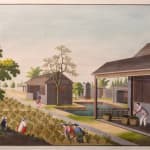A Set of 12 Chinese Trade Pictures – depicting the growing, harvesting and processing of tea
48 x 61 cm
Further images
-
(View a larger image of thumbnail 1
)

-
(View a larger image of thumbnail 2
)

-
(View a larger image of thumbnail 3
)

-
(View a larger image of thumbnail 4
)

-
(View a larger image of thumbnail 5
)

-
(View a larger image of thumbnail 6
)

-
(View a larger image of thumbnail 7
)

-
(View a larger image of thumbnail 8
)

-
(View a larger image of thumbnail 9
)

-
(View a larger image of thumbnail 10
)

-
(View a larger image of thumbnail 11
)

-
(View a larger image of thumbnail 12
)

Provenance
Supplied to Lord Grenville, Prime Minister of the United Kingdom, in 1803. Acquired in the early 1990s in London by Private Collector, USA.Exhibitions
Indianapolis Museum of Art, The Luxury of Tea & Coffee – An Exhibition of Chinese Export Porcelain from a Private Collection, April 2011 – March 2012.Literature
Pauline Webber, Head of Paper, Books & Paintings Conservation, ‘A souvenir from Guangzhou’ in the V&A Conservation Journal (Autumn 2004: Number 48), pp. 2-4.Carl L. Crossman, The Decorative Arts of China Trade: Paintings, furnishings and exotic curiosities (The Antique Collectors’ Club, 1991), pp. 173-181 – similar scenes of sets of watercolours in which Western merchants negotiate over the purchase of tea are depicted.
Notes: Formerly compiled in a leather bound album inscribed and dated ‘Lord Grenville, Chinese Drawings ft. 1803.’
The Lord Grenville was a close ally of his cousin, William Pitt the Younger, undertaking several posts in his Government including that of Foreign Secretary from 1791-1801, eventually succeeding him as Prime Minister in 1806-7. During his leadership he was responsible for pushing through the law abolishing the slave trade. In the 1790s he commissioned Samuel Wyatt, the celebrated neo-classical architect and friend of Matthew Boulton, to design and build Dropmore House, with distant views of Eton College and Windsor Castle.
From the middle of the eighteenth century, trade increased between China, England, America and Europe for tea, porcelain and silk, leading to curiosity about life in the exotic east. Chinese Trade paintings offered a glimpse of the culture, trade, commerce and topography of Asia to the English, who were curious to learn more about this distant place. Western traders commissioned albums portraying people and scenes of daily life – images of Chinese culture which could be taken back to the West. Trade paintings were executed in Chinese studios by a number of painters, each specialising in one aspect. Whilst works by Chinese artists traditionally lacked perspective, in order to meet the taste of the Western market and influenced by Western prints and artists arriving in Asia, trade paintings exhibited an interesting combination of techniques.
This series of images depicts the production of tea and is based on the Chinese tradition of Gengzhi tu. The first known Gengzhi tu example dates back to the Song dynasty (906-1279) and is attributed to the artist Lou Zhou (1090-1162). During the Qing dynasty, it became popular to depict the main trade production processes – the growing and processing of tea, the making and decorating of porcelain, the production of silk and the cultivation of rice – in fact the Emperor Kangxi (1662-1722) commissioned a Gengzhi tu album. The images have both an aesthetic and a didactic function, providing accurate information about the technical steps of the production process but placed in an idyllic setting, depicting an idealised image of life in the Chinese countryside, glorifying the trade between China and the West and appealing to the romantic image of the Orient.
Planting the tea bushes
Cultivating the plants
Picking the tea leaves
Bringing the Tea from the Fields for Sorting and Drying
Drying and Sorting
Pounding the Leaves
Bringing the tea for firing
Firing the tea
Packing Tea and Weaving Boxes
Loading the Tea for Canton
A Tea Hong in Canton












